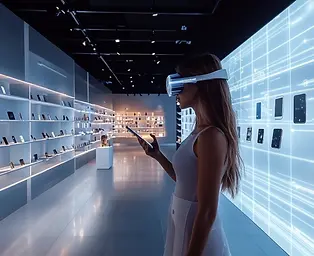
Phyigital Retail

Brand+Digital+Space
Narrative:
The future of retail design is being redefined by the dominance of smartphones as the primary shopping gateway. As consumers increasingly expect a seamless, real-time connection between digital and physical experiences, retail spaces must evolve beyond traditional storefronts. They are becoming immersive brand destinations where customers engage with products in ways that cannot be replicated online. This shift demands a new approach that blends physical presence with digital intelligence to create memorable, multi-sensory journeys.
Design:
Future retail environments will prioritize a "phygital" experience — a fusion of physical and digital touchpoints. Spaces will be highly immersive, flexible, and data-driven, seamlessly integrating mobile technologies into the customer journey. Store layouts will be adaptable for personalization and dynamic experiences, while interactive features such as smart displays, mobile-enabled browsing, augmented reality, and responsive environments will enrich customer engagement. Every design element will be strategically curated to extend the brand story across both physical and digital landscapes.
Outcome:
By creating multi-sensory, digitally connected environments, brands will deepen customer relationships and strengthen loyalty. Retail spaces will function not only as places of transaction but as hubs of experience, offering value that smartphones alone cannot deliver. The result will be stronger emotional bonds, amplified brand presence, and a competitive advantage in a mobile-first world where meaningful, memorable in-person experiences become a key differentiator.
1. Experience-Driven Spaces with AR/VR Integration
-
Retail spaces will use augmented reality (AR) and virtual reality (VR) to create interactive showrooms where customers can scan products with their phones for enhanced details, virtual try-ons, or personalisation options.
-
VR “portals” in-store may allow customers to walk into virtual worlds where they can interact with the full range of a brand’s products without the physical inventory limitations, deepening brand storytelling and creating memorable experiences.
2. Seamless Phygital Shopping Zones
-
As shopping on smartphones becomes more integrated with in-store experiences, spaces will encourage a smooth online-offline transition. Customers might shop in-store by scanning QR codes for more details, reviews, or to order out-of-stock items directly to their homes.
3. Flexible, Modular Layouts for Fast-Paced Adaptability
-
Interior layouts will shift toward flexibility, allowing brands to reconfigure spaces quickly for pop-ups, new product launches, or seasonal displays that mirror what’s currently trending online. Movable walls, adaptable lighting, and changeable displays can accommodate new collections or digital showcases on short notice.
4. Social Media-Worthy Design Elements
-
Retail interiors will increasingly feature “Instagramable” moments, where aesthetic design elements encourage customers to photograph and share their experiences. This can include thematic installations, artist collaborations, or highly creative decor—bridging in-store visits with digital engagement and helping retailers capture organic social content.
-
Spaces may also have dedicated selfie zones or customisable backgrounds, enhancing the allure for digital-savvy customers who see shopping as a social activity and a way to build personal brand identities online.
5. AI-Enhanced, Data-Driven Environments
-
Retail interiors will use AI and IoT (Internet of Things) technologies to adapt in real time based on customer flow, peak hours, or personal preferences. This can include dynamic lighting, interactive screens, or even personalised greetings as customers enter the space with their smartphones. By connecting with apps or loyalty programs, stores can create a personalised in-store experience with product suggestions or exclusive offers.
-
Voice-Activated Shopping. With the rise of virtual assistants, voice commands will simplify the shopping process, particularly for mobile users on the go. This could mean hands-free shopping experiences, allowing customers to search for items, make purchases, and check order statuses seamlessly.
6. Sustainably-Minded, Minimalist Designs
-
With consumer awareness of sustainability growing, retail interiors will prioritise eco-friendly materials and designs that reflect environmental consciousness. Minimalist, nature-inspired interiors—often highlighting the brand’s environmental impact through digital displays or product storytelling—will help connect with eco-conscious customers.
7. Touch-less and Autonomous Shopping Experiences
-
Many stores will incorporate touch-less technology—automatic doors, digital payments, and contactless information displays—minimising physical interactions and promoting a seamless, low-touch experience. Some may even explore AI-driven autonomous shopping, where customers pick items and simply walk out with their purchases as the app handles checkout and payments.
8. Community and Co-Creation Hubs
-
In the future, retail stores will serve as community spaces where customers can participate in workshops, social events, or co-creation sessions. For instance, fashion brands may offer customisation stations where customers design products alongside in-house experts, combining shopping with shared creative experiences that customers can document and share via smartphones.
9. Enhanced Product Transparency and Education Areas
• With smartphones enabling deeper research and brand scrutiny, retail interiors will allocate dedicated spaces for
product transparency, where customers can learn about sourcing, production, and sustainability practices. Interactive screens or “transparency walls” will allow customers to access in-depth product information by scanning codes or tapping into the brand's online resources.
Spatial Development






